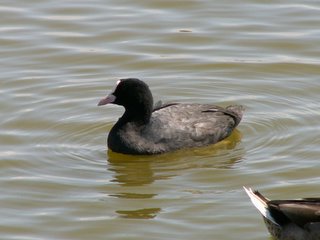This hot summer days are an invitation for a walk in the park.
In these walks I found one curious lizard also enjoying the sun!
These are the photos:


In the hole Looking at me:

Relatos das aventuras e desventuras de um BTT'nista na Cidade mais Alta
 The mallard is a large and heavy looking duck. It has a long body and a long and broad bill. The male has a dark green head, a yellow bill, is mainly purple-brown on the breast and grey on the body. The female is mainly brown with an orange bill. It breeds in all parts of the UK in summer and winter, wherever there are suitable wetland habitats, although it is scarcer in upland areas. Mallards in the UK may be resident breeders or migrants – many of the birds that breed in Iceland and northern Europe spend the winter here.
The mallard is a large and heavy looking duck. It has a long body and a long and broad bill. The male has a dark green head, a yellow bill, is mainly purple-brown on the breast and grey on the body. The female is mainly brown with an orange bill. It breeds in all parts of the UK in summer and winter, wherever there are suitable wetland habitats, although it is scarcer in upland areas. Mallards in the UK may be resident breeders or migrants – many of the birds that breed in Iceland and northern Europe spend the winter here. All-black and larger than its cousin, the moorhen, it has a distinctive white beak and 'shield' above the beak which earns it the title 'bald'. Its feet have distinctive lobed flaps of skin on the toes, which act instead of webs when swimming. It patters noisily over the water before taking off and can be very aggressive towards others..
All-black and larger than its cousin, the moorhen, it has a distinctive white beak and 'shield' above the beak which earns it the title 'bald'. Its feet have distinctive lobed flaps of skin on the toes, which act instead of webs when swimming. It patters noisily over the water before taking off and can be very aggressive towards others.. A delightful small, long-tailed and rather sprightly black and white bird. When not standing and frantically wagging its tail up and down it can be seen dashing about over lawns or car parks in search of food.
A delightful small, long-tailed and rather sprightly black and white bird. When not standing and frantically wagging its tail up and down it can be seen dashing about over lawns or car parks in search of food. A highly coloured finch with a bright red face and yellow wing patch. Sociable, often breeding in loose colonies, they have a delightful liquid twittering song and call. Their long fine beaks allow them to extract otherwise inaccessible seeds from thistles and teasels. Increasingly they are visiting birdtables and feeders.
A highly coloured finch with a bright red face and yellow wing patch. Sociable, often breeding in loose colonies, they have a delightful liquid twittering song and call. Their long fine beaks allow them to extract otherwise inaccessible seeds from thistles and teasels. Increasingly they are visiting birdtables and feeders.  The males live up to their name but, confusingly, females are brown often with spots and streaks on their breasts. The bright orange -yellow beak and eye-ring make adult male blackbirds one of the most striking garden birds.
The males live up to their name but, confusingly, females are brown often with spots and streaks on their breasts. The bright orange -yellow beak and eye-ring make adult male blackbirds one of the most striking garden birds.
House sparrow - Passer domesticus (Pardal Comum)
Identification Tips:
Length: 4.25 inches
Small, seed-eating bird
Thick, conical bill
Pink legs
Extremely common in urban and agricultural areas
Adult male: 
>Gray crown
>Black throat, upper breast, and small mask; less black on throat in winter
>Grayish side of neck and underparts
>Rusty-brown nape and upperparts
>Black streaks on back
>White patch in wing
>Gray rump
>Black bill in summer; yellowish in winter



 The roads became traps to cars, cleaning was needed...
The roads became traps to cars, cleaning was needed...


Scientific Name : Upupa epops
Status: Scarce passage migrant.
Habitat: On passage mostly found in coastal fields, dunes, golf courses, etc.
Description: Combination of pied and pinkish plumage and long crest unique.
Size: 26 - 28cm (10.5")


Info for the nature lovers
This photos were taken in portugal near Spain.